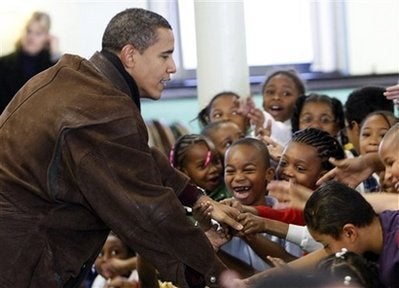
The Campaign Finance Institute (CFI) study disclosing that Barack Obama actually raised most of his campaign money from "larger" not "small" donors has gained wide, approving, coverage in recent days, from USA Today to the New York Times and Los Angeles Times and countless web sites, even making Huffington Post at least twice, including as a top link. Inevitably the headlines refer to the "myth" of Obama riding a wave of small donations to victory. That study's author himself uses it.
But the "myth" is actually in the spinning of the report, including by its author, Michael Malbin, a former speechwriter for Dick Cheney, when he was Pentagon chief, and a resident fellow at The American Enterprise Institute from 1977 to 1986.
As usual in these cases, it's not that the numbers are wrong, it's the analysis and how the interpretation is being played by the media. Because, buried in the report, are all the figures and arguments for showing that the CFI's "myth" is actually a myth.
Let us count the ways. There are many more that I could (and perhaps will, time permitting) add. I will also be quite willing to correct any of the numbers or my own analysis:
1. Did many in the media actually allege that most of Obama's total funding was coming from small donors -- or just that he was being helped along significantly by them and that the number of new and smaller donors was unprecedented? All of that, in fact, is true, based on the study. In fact, even accepting the CFI's tight definition of "small," these people donated more than half of what McCain was able to raise in total.
2. More importantly, what is a "small donor"? The report suggests that giving more than $200, in aggregate, takes you out of the "small" level. Between $200 and $1000 represents "mid-range" with over $1000 "large." There are two problems with this.
Why would $199 be small but, say, $299 not? It's an awfully arbitrary breakdown. Second, what is really "small"? With fat cats bundling millions, and many able to give up to $4600 individually, why not define "small" as, say, under $500 or under $800? This would change the numbers dramatically.
For example, much has been made of the percentage of "small money" (under $200) for Obama being only one point higher than that for Bush in 2004 (26% vs. 25%). But if you consider "small" a figure of $999 or less (in aggregate, often made up of repeated small donations), the Obama figure comes to 53%, while Bush stops at 38% and McCain at 41% -- quite a difference.
3. Many people started by giving less than $200 but then kept giving more, putting them in the mid- or high-level categories. It's valid to combine them, except that the study insists on comparing Obama's race and fundraising with past campaigns. And there's no comparison. None of the candidates in the past two cycles campaigned for almost two years, and were engaged in brutal primary fight that ended little more than two months before the party's convention. Kerry, Bush, and McCain all had relatively brief (or no) primary battles. So the Obama fundraising went on much, much, longer, by necessity.
Yet by CFI's definition, if you gave Obama $100 in 2007, then $100 when he kept battling Clinton in the spring of 2008, and then another $100 in September 2008, you were not a "small" donor.
4. Even putting aside all this, the report relates, deep within, that Obama, in fact, received donations under $200 from a staggering 2.5 million people -- completely unprecedented. A closer look at the actual figures show that Obama got over $115 million from these donors -- while the other three got only in the range of $40 to $50 million. The study also notes that Obama's 2.5 million donors equaled the combined number of such donors for all candidates in 2004. Yet the media is now being accused of pushing the "myth" that there was something extraordinary about Obama's relation to small donors. Even accepting the report's definition, Obama received twice as much "small funding" as did Hillary Clinton.
5. Also buried in the report is that, guess what -- McCain likely topped Obama by at least $10 million in the really big funds put together by "bundlers." The only place he held an advantage.
6. Finally, for now, also getting little attention in the press reports on the study is this line: "Forty-seven percent of Obama's money came from large donors compared to 56% for Kerry and 60% for both Bush and McCain." Yes, this is not night-and-day -- but still, gives lie to the spin that claims the report showed there was very little difference between the Obama funding and past campaigns.
Greg Mitchell is editor of Editor & Publisher. His latest book, on Iraq and the media, is "So Wrong for So Long." He has written two books for Random House on classic U.S. election campaigns, "The Campaign of the Century" and "Tricky Dick and the Pink Lady," and he has just completed a book on the 2008 campaign.
